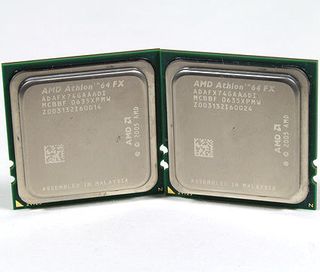AMD's 4x4 Platform & Athlon 64 FX-70 - Brute Force Quad Cores
Athlon 64 FX-70 Family Kicks Off Double-Socket Dual Cores

The Core 2 Duo processor launch on July 14 marks a turning point in the CPU world. It was on this day that AMD lost its dominance over Intel in the desktop processor space, a lead that had lasted for almost three years. Simply put, Core 2 Duo processors are faster and more energy-efficient than the Athlon 64 product family. While energy efficiency has to be evaluated for complete systems rather than only by processors, AMD still offers lower entry-level pricing. Clearly, AMD had to go back to the drawing table to come up with an adequate answer to Intel's challenge. Ladies and gentlemen, here it is: the 4x4 Quad FX platform, with dual-socket Direct Connect architecture for enthusiasts.
It is no secret that Intel has had a head start of at least nine months when it comes to manufacturing technology. All Core 2 Duo chips, the latest Xeons, and many of the Pentium D processors are based on the top-notch 65 nm process. Smaller transistor structures allow for lower energy consumption, more features (such as huge cache memories) and more processing cores on a chip. It is for this very reason that there is an Intel quad core (using two Core 2 pieces), but no AMD counterpart. The fact that AMD's current 90 nm silicon-on-insulator process is more advanced than the Intel equivalent doesn't help - a 90 nm quad core would simply be a huge (and expensive) piece of silicon.
AMD will introduce its first generation 65 nm products on December 5, which paves the way for a future quad core CPU. The initial 65 nm processors will target the entry level and the mainstream, though, and we will have to wait several more months before high-end 65 nm AMD processors hit the shelves. The 65 nm quad core Agena FX, with dedicated L2 caches and a unified L2 cache, is not expected before summer 2007. Until then, AMD had to come up with a solution to keep Intel's pace and show off innovation, because the first 45 nm Intel processors are very likely to arrive as soon as late 2007.
Quad FX is AMD's solution to the quad core issue, but what is it all about? AMD decided to appeal to the uber-enthusiast by offering a dual-processor platform that addresses the needs of so-called "megatasking environments". In short, that means doing everything you want at once. The platform technology could conveniently be taken from the Opteron world: Quad FX consists of a dual Socket 1207 motherboard using the beefed-up Nvidia nForce 680a chipset, and a pair of Athlon 64 FX-70 processors. Unlike the Opteron world, the Socket 1207 Athlon 64 FX processors do not require registered memory; they run on conventional DDR2-800 DIMMs - two per processor. To make the whole thing really attractive, AMD offers FX-70 bundles, which always consist of two FX-70, FX-72 or FX-74 processors (corresponding to speeds from 2.6 to 3.0 GHz).
The real question, of course, is if the result is worth the effort. We've put one of the first Athlon 64 Quad FX-74 systems to the test - and found out that this question is not that easy to answer.
Join our discussion on this topic
Stay on the Cutting Edge
Join the experts who read Tom's Hardware for the inside track on enthusiast PC tech news — and have for over 25 years. We'll send breaking news and in-depth reviews of CPUs, GPUs, AI, maker hardware and more straight to your inbox.
Current page: Athlon 64 FX-70 Family Kicks Off Double-Socket Dual Cores
Next Page Who Needs Two Processors And Four Cores Anyway?Most Popular

